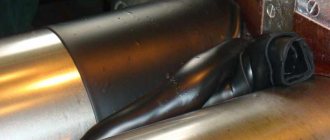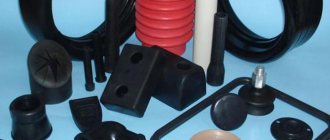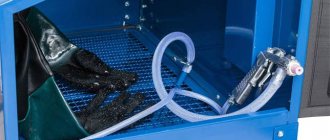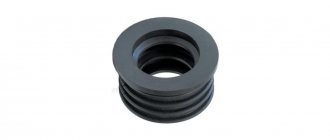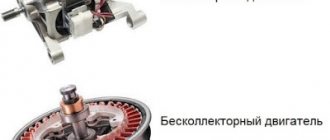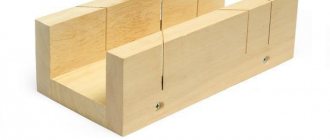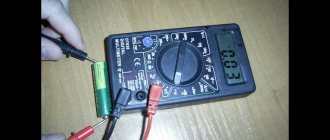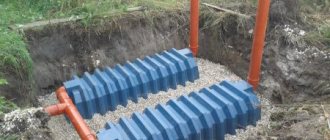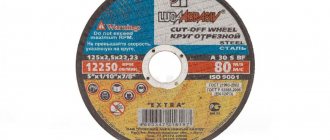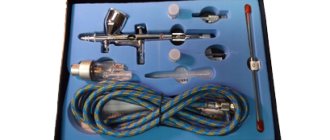Concept of vulcanization
Vulcanization is a chemical process during which raw rubber, improving the properties of the material in strength and elasticity, becomes rubber. In fact, rubber can be used as a special glue to seal a puncture in an inner tube or tire. Rubber vulcanization processes are as follows:
Hot vulcanization method
- electric;
- sulfuric;
- hot;
- cold.
Types of rubber
Rubber is one of the few materials that has different hardness. Depending on the percentage of sulfur, it is:
- soft – contains up to 3% sulfur;
- semi-solid – from 4 to 30% sulfur;
- hard – more than 30%.
Soft rubber Hard rubber
Semi-hard rubber
Rubber is a natural material, and as a rule, products made from natural ingredients are of the highest quality and most durable. Therefore, components for bicycle and car wheels are made of soft rubber, which is based on rubber.
Vulcanization - raw rubber - Great Encyclopedia of Oil and Gas, article, page 1
Vulcanization - raw rubber
Page 1
Vulcanization of raw rubber is carried out at elevated temperatures in autoclaves, molds or other equipment. [1]
During the vulcanization process of raw rubber, accelerators are added, which significantly reduce the time required for complete vulcanization and at the same time improve the quality of the rubber. The use of especially active accelerators reduces the duration of the vulcanization process by almost 20 times. The domestic industry produces two main types of accelerators - thiuram and diphenylguanidine. The first one is more active than the second one. Thiuram is available in the form of a yellowish powder, diphenylguanidine - in the form of a white or light yellow crystalline powder. [2]
Reinforced and non-reinforced parts are produced by pressing and vulcanizing raw rubber directly on the press in open and heated injection molds. The technological pressing process consists of the following operations. [3]
At 145 C, the vulcanization time for most types of raw rubber is 15 - 50 minutes. [4]
O-shaped rubber rings are made by vulcanizing raw rubber in molds. As a result of a complex physicochemical process, rubber macromolecules form a spatial structure, and rubber turns from plastic into a durable elastic material. [5]
The sealing washer can be made by vulcanizing raw rubber in the core socket, in a mold, thereby achieving good connection with the socket. The disadvantage is that if the rubber becomes damaged during operation, the entire core has to be replaced. [7]
Depending on the type of rubber and the design of the apparatus, vulcanization of raw rubber is carried out in one of the following ways: a) live steam in a vulcanization boiler; b) open method; c) superheated steam; d) live steam directly in the apparatus itself. [9]
The last step in the production of relin is the duplication of two layers and vulcanization of the raw rubber. [10]
In Fig. 48 shows typical products obtained by pressing and vulcanizing raw rubber. [12]
Instead of sheet polyisobutylene, soft rubber linings (rubber grades 829, 2566, etc.) can be used as a sublayer under diabase tiles, but with this method of protection it will be necessary to vulcanize the raw rubber after gluing the device, which is not always easy to do. In the current production, the hydrator is protected by a coating consisting of three layers of rubber grade 2566, on top of which diabase tiles on diabase putty are laid in two layers. Nozzles made of X18N12M2T steel are inserted into narrow fittings using diabase putty; Apparently, diabase liners can also be used for this purpose. The specified coating is used for an average of 3 years; During this period, the damaged lining in the neck of the apparatus was corrected. [13]
Instead of sheet polyisobutylene, soft rubber linings (rubber grades 829, 2566, etc.) can be used as a sublayer under diabase tiles, but with this method of protection it will be necessary to vulcanize the raw rubber after gluing the device, which is not always easy to do. In the current production, the hydrator is protected by a coating consisting of three layers of rubber grade 2566, on top of which diabase tiles with diabase putty are laid in two layers. Nozzles made of X18N12M2T steel are inserted into narrow fittings using diabase putty; Apparently, diabase liners can also be used for this purpose. The specified coating is used for an average of 3 years; During this period, the damaged lining in the neck of the apparatus was corrected. [14]
During vulcanization work, the following are possible: hand injuries when working on presses and cleaning machines; injury due to explosion of steam vulcanization apparatuses; burns when touching heated parts of vulcanization installations and when steam breaks through; electric shock when working on electric vulcanizers and using electrical installations; poisoning by solvent vapors and gas emissions during the vulcanization of raw rubber. [15]
Pages: 1 2
www.ngpedia.ru
Electrical vulcanization of rubber
In general, vulcanization can be cold or hot. The electrical vulcanization process is a hot method. An electric stove with a ceramic heater is used as a heater at home; a hair dryer or a regular iron is also suitable. The optimal temperature for this method is 145С. To determine the temperature, you can also use available means, for example, if a sheet of paper begins to char, it means that the temperature has reached the required values.
Electrical vulcanization of rubber
There are also special clamps with a heating element. Such devices can operate from a 220V household network, from a car battery, through a cigarette lighter socket, or from their own battery. It all depends on the performance of each device. These clamps are easy to use; you need to attach a rubber patch to the camera, clamp it and plug it into the network.
Sulfur vulcanization of rubber
After rubber vulcanization
This operation consists of a chemical reaction in which sulfur atoms are added to the rubber. When added up to 5%, it produces raw materials for the manufacture of tubes and tires. In the case of gluing two elements, sulfur helps connect the rubber molecules, forming a so-called bridge. This procedure refers to the hot method, but it is unlikely that it will be possible to do it on a hike or on the highway.
Hot vulcanization
Rubber, as a raw material, has the property of being welded into a single composition at a temperature of 150 °C. As a result of this process, the rubber becomes rubber and cannot return to its original position. Thanks to its capabilities, rubber can fix any punctures and cuts in the tube and tire.
It is necessary to vulcanize rubber using a hot method, only using a press. The depth and area of the cut will tell you how long to weld. Typically, it takes 4 minutes of cooking to repair a 1mm cut. Accordingly, if the cut is 4mm, then it needs to be vulcanized for 16 minutes. In this case, the equipment must be warmed up and configured.
By performing hot vulcanization at temperatures above 150°C, you can ruin the rubber and achieve nothing, since the material will deteriorate and lose its characteristics.
Using clamps or a press allows you to properly patch the damage. After finishing the work, you should make sure that there are no voids or air bubbles in the seam. If there are any, you need to clean the puncture site from fresh rubber and repeat the whole process again.
In order to hot seal a camera at home, you must do the following. From raw rubber, you need to cut a piece slightly smaller than the patch itself. The tube or tire is cleaned slightly wider at the damaged area, to a rough state, and then degreased with gasoline. When preparing the patch, you need to cut the chamfer at an angle of 45°, also sand and degrease. Then we cover the puncture site with a patch, clamp it in a vice and heat it to the desired temperature.
If you dissolve raw rubber in gasoline, you can get a special glue for rubber, the use of which improves the quality of the seam. Particular attention should be paid to temperature conditions. Vulcanization is carried out at a temperature of 140 - 150 ° C; if there is a smell of burnt rubber, it means the patch has overheated, and if it has not merged with the overall product, then it may not have reached the required temperature. To prevent rubber from sticking to metal, you need to place paper between them.
Rules for patching cameras
- All punctures are cleaned with a grinding stone or sandpaper. The explanation is simple: not only does this remove dirt on the surface of the chamber, but the rough surface also has a large contact area with the patch.
- All cuts are sanded down so that their opposite edges cannot touch after applying the patch. As you move, the edges of the cut will rub against each other, which threatens to quickly tear off the recently applied patch.
- The patch can be of any shape, but in size it must cover the puncture or cut with an overlap of 2 cm or more.
Cold vulcanization
Nowadays, using this method is not difficult, since you can purchase a repair kit in every auto or bicycle parts store. The contents of this set may vary, but each one contains patches and special glue.
Cold vulcanization of rubber
The repair procedure in this case is similar to the hot method. You also need to treat the damaged surface with an abrasive, remove rubber dust and degrease. After drying, apply glue to the camera and glue the patch. In this case, it is not the duration of the pressure that plays a role, but its strength. Therefore, it will not be enough to simply press down with a stone; more force is required.
Do-it-yourself cold vulcanization of rubber is a fairly simple process that can be performed wherever you are if you have a special kit. However, raw rubber is not made with your own hands at home. For such work you need special equipment.
Making a vulcanization device
Each vulcanizer has two main elements - a heating part and a clamping device. The basis of such rubber processing equipment can be used:
- iron;
- “bazaar” electric stove;
- piston from the engine.
In a device with an iron, the heating part is the surface that is used for ironing in everyday life. If we plan to use an electric stove, then the heating coil should be covered with a metal sheet, and when working, you need to place paper between the rubber and the metal. Such a device must be equipped with a thermostat to avoid overheating of the material.
The pressing part of the vulcanizer is easiest to make from a clamp. The simplest device to manufacture would be a device consisting of an iron and a clamp. Since they are both metal, joining them using arc welding is not difficult. The iron also has a thermostat.
A piston vulcanizer also uses a metal plate. A rubber bladder is placed on it. The piston, with its smooth part, which is in contact with the explosive mixture in the engine, presses down the patch using a homemade clamp. Paper is also placed between the piston and the patch. After that, gasoline is poured into the piston and ignited.
Such a device made from a piston is especially useful on the road, when there is no way to connect to the electrical network. However, such a device does not have a thermostat, and the temperature will have to be controlled manually.
Piston mechanism
A piston from a car or motorcycle is used as a design element. This vulcanizer does not require electricity. This requires a supply of 50 g of gasoline.
- The base is cut out of wood. Wood does not interfere with the heating of the rubber.
- A beam 10 mm thick is made of metal.
- In the wooden base and beam along the edges, 2 holes are drilled for M12 bolts.
A camera with a patch is placed on a wooden plank. A cylinder filled with gasoline is placed on top. And the entire structure is bolted together. The gasoline is set on fire. After it burns, time is given to cool. And then he sorts it out.
A vulcanizer is a very important device for a motorist. It is especially necessary on the road in case of an unforeseen situation. There is no point in making an expensive purchase at home. Since such a device can be made from used devices.
no similar articles found 
Pros and cons of vulcanization
The main advantage of the tire repair process is that it is cheaper to repair than to buy a new one. However, each situation is individual, so it is important to determine whether repairs will save the situation.
The cold method is quite easy to use, it will not take much time, and the costs will be minimal. The main disadvantage of this method is the unreliability of gluing. This procedure is temporary, and you should contact a service station as soon as possible.
Hot vulcanization reliably welds rubber, allows such work to be carried out at any temperature and has a low cost.
So, you can repair a tube or tire in different ways, but it is better to entrust this work to specialists, because it is for your own safety.
Cement vulcanizer
Cement for vulcanization is sold in cans, like those from manufacturers BL, OTP, Tip Top RAD, or aerosol cans: Zefal Repair spray, Abro Quick fix tire, Tire sealer. These compositions are non-toxic because they do not contain aromatic and chlorinated hydrocarbons.
Cementation of the liquid vulcanizer begins at a temperature of 18 degrees. Hot vulcanization at temperatures up to 150 degrees is also applicable to it.
The repair process is simple, you don’t even need to remove the wheel from the bike, just:
- pull out the foreign object from the rubber;
- fill the chamber with sealant through the nipple;
- slightly inflate the tire;
- drive approximately 2-3 kilometers and finally bring the pressure to the desired value.
